
| What is Flavor and Fortune? |
| How do I subscribe? |
| How do I get past issues? |
| How do I advertise? |
| How do I contact the editor? |
Read 12984223 times
Connect me to:
| Home |
| Articles |
| Book reviews |
| Letters to the Editor |
| Newmans News and Notes |
| Recipes |
| Restaurant reviews |
| Article Index (all years, slow) |
| List of Article Years |
| Article Index (2025) |
| Article Index (last 2 years) |
| Things others say |
| Related Links |
| Log In... |
| Authors |
| Categories & Topics |
Bai Food Specialties in Dali
| by Wang Si |
Chinese Ethnic Minorities and Their Foods
Winter Volume: 2012 Issue: 19(4) page(s): 5, 6, and 36
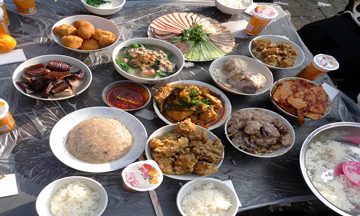 Let me explain a popular new word in daily life; it can also be found when surfing the internet; it is chi huo. This is best translated as 'eating machine' and used to describe a lazybones who does not work, just eats. There was a time when we were ashamed to talk about food in public, but nowadays, with the fast development of the foodservice industry, people have more freedom to discuss food. And, there are now more and more gastronomes who call themselves chi huo.
Let me explain a popular new word in daily life; it can also be found when surfing the internet; it is chi huo. This is best translated as 'eating machine' and used to describe a lazybones who does not work, just eats. There was a time when we were ashamed to talk about food in public, but nowadays, with the fast development of the foodservice industry, people have more freedom to discuss food. And, there are now more and more gastronomes who call themselves chi huo.
Now, this nickname shows enthusiasm for those who adore tasting delicacies, looking for good restaurants, and for sharing specialties local or further afield. It should be easy for them to recommend some special food in their hometown or another place, but it is not that easy when selecting ones on a trip. This is a real problem when these people spend very few days in one place. Some foods they taste and tell about are foods others have told them with amazing detail. Such stories can mislead the appetite.
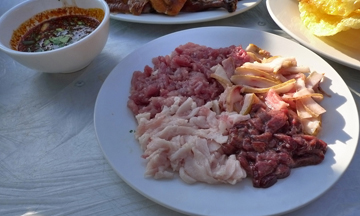 An eating machine is not only driven by these tales, but also by the good looks and the aroma of dishes. Sometimes the ingredients and their preparations fascinate. These push these folk to try more and learn more. Though I am not a chi huo, just a student of food culture, I am going to share with you some of these tales, actual experiences I had in the Dali Bai Autonomous Prefecture in the Yunnan Province. I plan to tell you about some special foods locals I found served and loved there.
An eating machine is not only driven by these tales, but also by the good looks and the aroma of dishes. Sometimes the ingredients and their preparations fascinate. These push these folk to try more and learn more. Though I am not a chi huo, just a student of food culture, I am going to share with you some of these tales, actual experiences I had in the Dali Bai Autonomous Prefecture in the Yunnan Province. I plan to tell you about some special foods locals I found served and loved there.
Before doing that, you need to know that the question of where Bai ancestors came from is still a controversy. However, one thing without doubt is that they are an ethnic group with many influences of and in the Han culture. Many Chinese, even the Bai themselves, admit that they are the closest minority to the Han but with many of their own ways to tell their own identity. Among them, food is believed an important part.
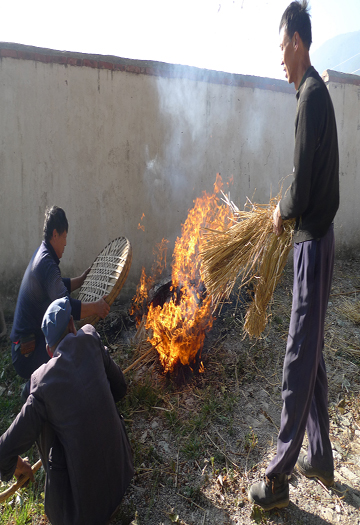 BAI, PIG KILLING CUSTOM is like in many other cultures, especially in the countryside of China. Bai people have an annual pig custom, but they kill a pig in a different way. There is a saying that goes: A dead pig has no fear of boiling water. This describes someone who never feels guilty or ashamed when doing evil things. Normally, people use boiled water when dealing with a freshly killed pig, but the Bai use fire because it closely relates to a very traditional dish in their food culture, one called 'Raw Meat.'
BAI, PIG KILLING CUSTOM is like in many other cultures, especially in the countryside of China. Bai people have an annual pig custom, but they kill a pig in a different way. There is a saying that goes: A dead pig has no fear of boiling water. This describes someone who never feels guilty or ashamed when doing evil things. Normally, people use boiled water when dealing with a freshly killed pig, but the Bai use fire because it closely relates to a very traditional dish in their food culture, one called 'Raw Meat.'
Referred to in Fan Chuo's volume translated as: Barbaric Book. In Chinese it is called Man Shu; it is a behavior was written down during the Tang Dynasty (618 - 907 CE). It says that the 'Bai have a habit of eating raw meat and treating it as the highest delicacy.' In the Yuan Dynasty, also known as the Mongul Dynasty (1279 - 1368 CE), some books specifically discuss this behavior in great detail. They say the Bai liked and did eat pork, beef, chicken, and fish sliced and raw and that they mixed it with mashed garlic. Even Marco Polo heard of this and reported it in his travel notes. This dish is still very popular among Bai people today. Outsiders clearly feel uncomfortable and most will not try it.
The process of serving raw meat is a bit similar to western barbecue. This meat is not served with blood on it. Actually when the pig is killed, there are three or more people prepared to, what they say, is 'to burn it.' How do they do this?
First, they put the killed pig on a pile of straw and ignite the straw. While it is burning, one man squats beside the animal and uses a flat bamboo basket to fan the fire. Another man holds a long stick to turn the straw so it burns completely. A third man adds more straw onto the fire. They do stop for some time, as one of them needs to shave the burned leather, usually with a kitchen knife. Then they change the pig's heating position and keep the fire burning.
The skin of the pig changes color depending on how it is heated. White means the hair is just cleaned away, gray means the hair it still there, while yellow and brown places without hair means it is burned enough and ready to eat.
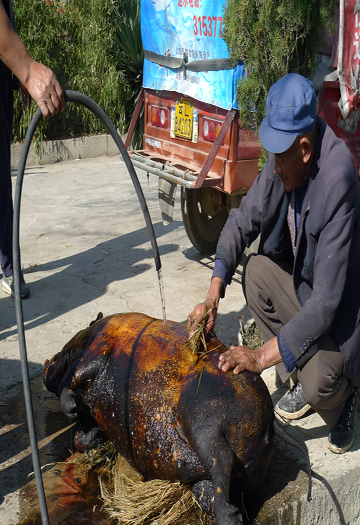 As soon as the whole pig turns the right color, these men stop the burning and pour water on the pig to cool it. Next, they rub the leather or skin back and forth with wet straw to make it soft and to give it the aroma of straw. After that, the leather appears amber and does crack in some places. Now, they turn the pig upside down, cut down the head end, then cut the stomach, and they carefully take it and all organs out. These they put into a tub. Next, they cut off the back legs and carefully peel the skin and the thin layer of meat next to it.
As soon as the whole pig turns the right color, these men stop the burning and pour water on the pig to cool it. Next, they rub the leather or skin back and forth with wet straw to make it soft and to give it the aroma of straw. After that, the leather appears amber and does crack in some places. Now, they turn the pig upside down, cut down the head end, then cut the stomach, and they carefully take it and all organs out. These they put into a tub. Next, they cut off the back legs and carefully peel the skin and the thin layer of meat next to it.
All this work is done by these three men. The pork skin and the meat are passed on to the women who slice the meat into small pieces and set the dish out looking orderly. Other women prepare the seasoning to go with the raw meat; this is called zhan shui, literally translated as: dipping water.
This raw meat dish is very typical in the Yunnan and Guizhou Provinces, but with different ingredients here and there. One example, in Dajianpang, a county on the east side of Erhai Lake where I went several times and spent a total of two months, the locals use nearly twenty ingredients to make their special sauce.
Some basic spices they use that you may be familiar with include salt, soy sauce, garlic, ginger, hot peppers, chili oil, Sichuan peppers, MSG, shallots, sesame seeds, sugar, and fresh coriander. There are others you may not know such as black cardamom also called amomum tsao-ko or Amomum subulatum Roxb., young leaves of knotweed or Polygonum viscosum Buch-Ham. exD. Don. lso used is chicken flavored mushroom oil, ground fried hemp seeds or Cannabis sativa, and stewed plums. All of these are mixed together. They give off a special fragrance and give this dish called Raw Meat an unforgettable taste. The pork and skin are fresh and soft, and they are easy to chew. This dish is only served the day they kill and prepare the pig.
Bai people in the city of Dali use stewed plums as a seasoning, often to replace vinegar. Every May and June, there are many ripe plums in Dali. Almost every family goes to pick some of these juicy fruits. In fact, there are several kinds of plums there to pick, many prepared differently. Some are sweeter, some more sour, some they pickle with hot pepper.
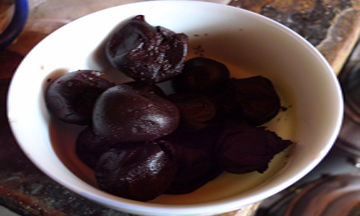 STEWED PLUMS, BAI STYLE are made by this ethnic minority population using bitter plums. They wash them and put them and hot water in a pottery jar to which they add salt. Every day after a meal, this jar is set on the remaining fuel, which can be coal, wood, and/or sawdust. These benefit from the warm heat. A few days later, they might add more plums, more salt, even more water. They keep reheating the jar and its contents until all the plums turn black and become very soft. It can take one month or more to get these plums stewed the way they like them. When the stewed plums are black, they store them in a big jar or in glass bottles.
STEWED PLUMS, BAI STYLE are made by this ethnic minority population using bitter plums. They wash them and put them and hot water in a pottery jar to which they add salt. Every day after a meal, this jar is set on the remaining fuel, which can be coal, wood, and/or sawdust. These benefit from the warm heat. A few days later, they might add more plums, more salt, even more water. They keep reheating the jar and its contents until all the plums turn black and become very soft. It can take one month or more to get these plums stewed the way they like them. When the stewed plums are black, they store them in a big jar or in glass bottles.
With urban rhythm impacting rural life, some traditional ways of serving food do change, and change quickly. As I learned from the locals, some now use a wok instead of a pottery jar, and they heat it using prepared honeycomb coal. They might heat it all day long never stopping, and do so for eight straight days, just adding hot water when necessary. I noted they usually stew ten or twelve pounds of bitter plums with one, two, or more pounds of salt to prevent the plums from over fermenting. These prepared black plums can be stored for several years without rotting. When they need some, the locals take out several plums and mash them with a little water, or make them into a sour sauce using vinegar. This mash can be eaten directly adding a lot of sugar, or they can put some in cool water to make plum juice. I also learned that locals use these stewed plums in cooking and to cure a cough or diarrhea.
Besides plums, local Bai people make pickled pears that are very popular and very delicious. There are many productive pear trees, but many are not very tasty. The Bai people reduce their sour and puckery taste by adding a lot of sugar to them; and these pears, when pickling is done, can only be stored for a half a year. They say that pickled pears are a good appetizer, effective for clearing heat and expectoration, and that they are easy to make; but how?
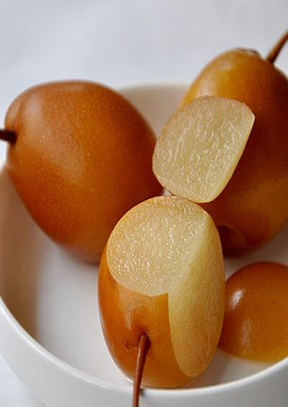 BAI PICKLED PEARS are made in a big jar with a narrow neck, or in a plastic bucket when making them, as follows:
BAI PICKLED PEARS are made in a big jar with a narrow neck, or in a plastic bucket when making them, as follows:
1. Wash the pears in fresh cold water. There is no need to have good quality pears, just those with no bad spots and not any rot.
2. Cover the bottom of the jar with slices or pieces of liquorice root using an amount according to ones personal taste.
3. Then, cover the liquorice root slices or pieces with a layer of sliced fresh ginger.
4. Put the pears on the ginger slices, and fill the jar close to its neck.
5. Add enough brown sugar around the spaces of the pears, or use honey instead.
6. Put another layer of liquorice root on the top of the pears.
7. Next, mix the set aside cold boiled water with salt in a ratio of 20 to 1, water to salt.
8. Pour this salty water into the jar until it covers the liquorice slices by an inch. Note that about ten pounds of pears need about seven quarts of salty water.
9. Seal the jar with plastic wrap and string. The pears will be ready in one month.
Note: Every time a pickled pear is removed, seal the jar again. These jars of pears can be stored for six to eight months.
Along with the pig feast and the above prepared fruits, the Bai enjoy another specialty called meat jelly. Its cooking can, in many ways, be considered a contrast to the raw meat.
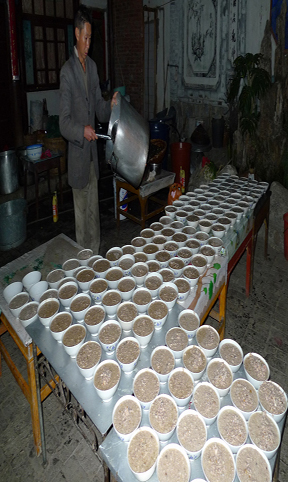 MEAT JELLY, Bai style means:
MEAT JELLY, Bai style means:
1. Putting boneless lean pork in previously boiled water, and adding salt, ginger and garlic. Bring to the boil, then remove the scum from the surface, and reduce the heat.
2. Simmer until the meat falls apart and is very tender, the liquid will be like a very thick soup. Remove this to a bowl and smooth the top.
3. Put the bowl outside if it is very cold, or in an airy place, or refrigerate it covered for some hours. In winter, the temperature in Dali is cold enough that it becomes jelly-like. In the countryside, people seldom have refrigerators.
Meat jelly is a natural way to made good use of the climate. However, many people move the bowls into their houses to keep cats and dogs from enjoying this dish. It is not uncommon for them to prepare one or two hundreds bowls, depending on the number of guests they plan to invite. The next afternoon, all the bowls of jelly will be served after turning each one upside down on a dish. Guests use spoons or chopsticks to enjoy this delicacy.
RU SHAN is also known as 'milk fan,' a popular dish made during the Bai pig feast and other times. Written during the Qing Dynasty (1644 - 1911 CE) and known as the Choreography of Dengchuan, Bai Chinese call it the Deng Chuan Zhou Zhi as it was written in Dengchuan, a place near Erhai Lake. There, milk fan was and still is very popular and sold piece by piece in their markets. Earlier, almost every rural family had and fed cows. A household with four cows could produce two hundred pieces of milk fan, and item easy to store in their cool climate. Some merchants did just that; then they would take theirs far away and sell it.
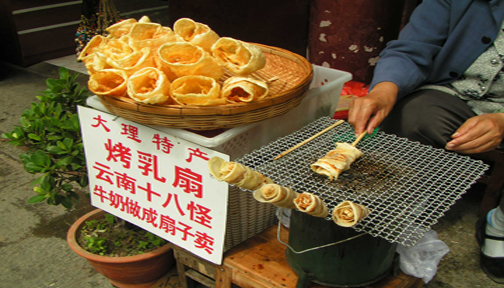 The process of making ru shan or milk fan is almost the same as what I saw in Dali where milk fan is made by hand in traditional ways. To make it they:
The process of making ru shan or milk fan is almost the same as what I saw in Dali where milk fan is made by hand in traditional ways. To make it they:
1. Boil fresh milk in sour water with the temperature between 70 and 80 degrees, the water coming from fermented milk.
2. Use a ladle and churn or mix it evenly in one direction. When the milk becomes a solid ball and thick like glue, one takes it out in a colander and kneads it for a while.
3. Quickly pull the glue-like ball, as one would a sheet, with a pair of sticks which are similar to chopsticks but much thicker.
4. Then, paste the elastic sheet of milk around a pair of longer sticks as pictured. These long sticks are made from bamboo, and a distance of an inch is between the sticks which are about three or four inches in diameter.
5. Bind the milk fan around the sticks with rope on and change that every few days. Each pair of sticks can be hold five sheets of this solid milk. Hang this in a well-ventilated place for several hours until the milk gets dry.
6. Finally, just pull off the solid milk and that is the milk fan. Every piece should be ten to twelve inches wide and as thin as parchment. One hundred pounds of fresh milk can make about fifteen pounds of milk fan. These can also be called raw milk fan and they can be used several ways.
Milk fan is fried when served at the pig feast, and coated with sugar or salt. Roasted milk fan is another popular snack sold at market stalls everywhere in the Dali Ancient Town. Sliced milk fan boiled with brown sugar, sesame seeds and walnut pieces is made as a sweet tea for the second set of 'Three Sets of Tea' or san dao cha. This is a Bai custom for guests and shows off their hospitality.
_____
Wang Si is a PhD candidate at Yunnan University where she majors in Ethnology. Her Masters degree was from Zhejiang Gongshan University in Hangzhou and for that degree she speciaized in the History of the Chinese Food Culture. Her doctoral studies concentrate on Symbiotic Anthropology. She is mainly interested in relations between food and the religion of the Bai people. We thank her for all the pictures that she took and shared to accompany this article.

Copyright © 1994-2025 by ISACC, all rights reserved
Address
3 Jefferson Ferry Drive
S. Setauket NY 11720